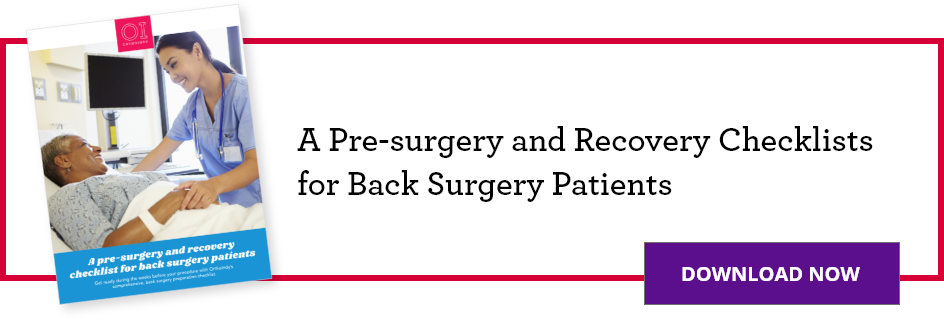Back surgery recovery begins long before you find yourself in the recovery room. If you’ve done everything you can before and after surgery, then your recovery time should be quick.
Read on to learn the nine steps you should take to ensure your mind, body, and environmentn are ready to help you heal.
Back surgery recovery tips
1. Create an exercise plan
Although it’s best to avoid aggressive exercise after a spine injury, exercising will help decrease back pain, increase circulation and enhance your mood.
Work with a physical therapist to create an exercise plan that includes a combination of strengthening, stretching and low-impact aerobic activity.
In addition, orthopedic doctors also recommend making an effort to move toward a healthier weight because it will reduce the stress on your spine before, after, and during back surgery recovery.
2. Stop smoking
If you smoke, consider giving up the habit to ease your suffering. Smoking leads to faster degeneration of your spine which increases back pain.
Likewise, try and make use of the time before and after your surgery to give up your smoking.
3. Fuel your body
Above all, the right nutrients enhance your immune system and speed the healing process.
- Eating foods rich in antioxidants and high in protein helps your body mend muscle and avoid infection
- Avoid sugary foods and processed carbohydrates because they increase inflammation
- Stay hydrated by drinking plenty of water
4. Prepare your home
In the weeks leading up to your surgery, prepare your home to make back surgery recovery time easier. After your surgery, you will not have the strength or ability to make big changes to your environment.
- Clear an indoor walking route of clutter, area rugs and other items that might make you trip (see step #6)
- Put items that you use frequently within easy reach—remember: you won’t be able to bend over or lift much post-surgery
- Get a chair with armrests and a firm seat; avoid chairs that make it difficult to stand
- Set up sleeping arrangements; your bed should not be too low to the ground or too high, which makes getting into and out of it a challenge; you should avoid water beds for this reason
- Make sure your toilet height is correct; invest in a toilet seat extension or handrail to assist standing
- Install a non-slip mat in your shower/tub
5. Find a caregiver
Your caregiver’s primary job is to cheer you on. Most patients need to arrange for help at home for four to six weeks after surgery. Make sure that the person you choose is dependable, and that you are comfortable having them see you not at your best.
Check that they understand how much you’ll need them. Your caregiver may need to help you:
- Provide support when you get into and out of chairs and your bed
- Grocery shop, prepare meals and eat
- Bathe and groom yourself
- Do household chores, like cleaning and laundry
6. Walk often during your back surgery recovery
Your primary source of exercise post-surgery will be walking. It reduces pain and aids the recovery process by preventing potential muscle atrophy and blood clots. Expect to be up and out of bed the day after your surgery and every day while you are in the hospital.
That is to say, as soon as you can, get moving.
While at home, walk your planned indoor route six or seven times daily. Do not walk anywhere you are unsure of the footing. And, as you increase your mobility, don’t forget: no BLTs (bending, lifting, twisting or stooping/squatting).
7. Be careful bathing and grooming
Do not submerge or wash your incision for two weeks after surgery. Instead, keep it dry by cleaning up with a wash cloth. During your first post-surgery doctor’s visit, your spine physician will inspect your incision, assess its healing progress and give you further customized instructions about care and cleaning.
8. Follow basic mobility instructions
Your physical therapist will teach you how to turn in bed, sit up and sit down. Follow these directions carefully. Almost all movements require you to “tighten your stomach muscles.”
For added support, expect to wear a customized back brace. Avoid moving other ways that can cause additional damage. Remember: no BLTs (bending, lifting, twisting, or stooping/squatting).
9. Be aware of wound risks
Your body is uniquely designed to deal with and heal wounds. However, sometimes your body has trouble. During healing, the area around your incision may become surrounded with dead tissue.
This necrotic tissue does not carry blood to the wound and it is extremely harmful to the body’s ability to recover and develop new skin.
Check the area around your incision for discoloration, aggravation, inflammation or anything that doesn’t look quite right. Enlist the help of your caregiver or another loved one to help you inspect your incision of signs of complications.
Schedule an appointment
If non-operative treatments have failed to get rid of your discomfort, back surgery might be right for you. If you have been getting nowhere with conservative treatments or wonder if it really makes sense to have spine surgery, we can help.
See one of the specialists on the OrthoIndy spine team for an initial diagnosis or second opinion. Call us at 317.802.2883 to schedule an appointment or make an appointment request online.
You might also like:

Checklist on Prepping for Back Surgery
Having back surgery? Find out what you can do now to make your recovery go smoothly and learn other ways to prepare, including what to pack and bring along to the hospital.






